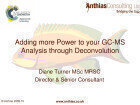Measurement and Testing
Adding More Power to your GC-MS Analysis through Deconvolution - Presented by Anthias Consulting Ltd at PEFTEC 2015
Jan 20 2016
Author: Diane Turner & Dr Imran Janmohamed on behalf of Anthias Consulting Limited
If you were not able to attend the PEFTEC conference in November 2015, here is an opportunity to view the presentation Diane gave on the day.
In separation techniques like gas chromatography, good chromatographic resolution is necessary to analyse sample components for both qualitative and most importantly accurate quantitative analyses. When separation techniques are hyphenated to mass spectrometry, like in GC-MS, another dimension of separation is added in the form of analytical resolution. This can reduce the necessity for good chromatographic resolution, unless components are isomers, but can also enable the separation of many more components in shorter run times. In the method development and in many cases the analysis of target compounds, significant ions can be extracted and compared to identify their retention times, frequently coeluting with other target plus matrix components. But when analysing a sample to identify unknowns, how do you know if you have chromatographically co-eluting peaks or components hidden under the baseline? This presentation looks at how deconvolution works and how powerful and useful it can be, even when just analysing target analytes in what looks like relatively clean samples.
More from Anthias Consulting Ltd>>
Digital Edition
PIN 25.3 June/July
June 2024
Analytical Instrumentation - Recent Advances In Various Bench Scale Accelerated Oxidative Testing Methods For Fuels - Petrochemical Industry: Anton Paar Solutions Streamline Processes, Reduce H...
View all digital editions
Events
Jul 30 2024 Jakarta, Indonesia
Jul 30 2024 Jakarta, Indonesia
China Energy Summit & Exhibition
Jul 31 2024 Beijing, China
Jul 31 2024 Chengdu, China
Aug 05 2024 Moon Township, PA, USA















